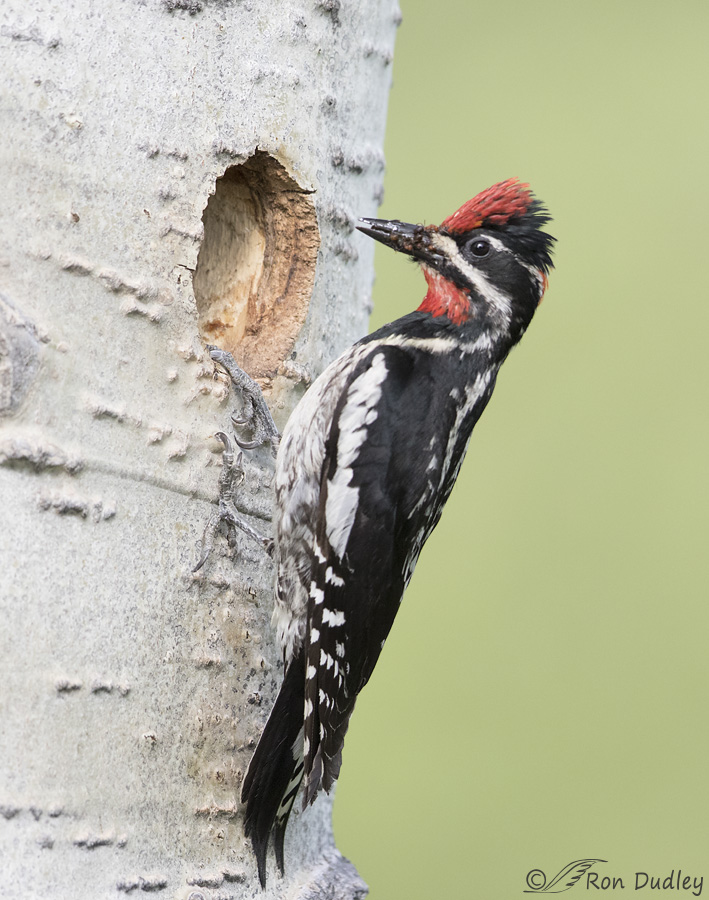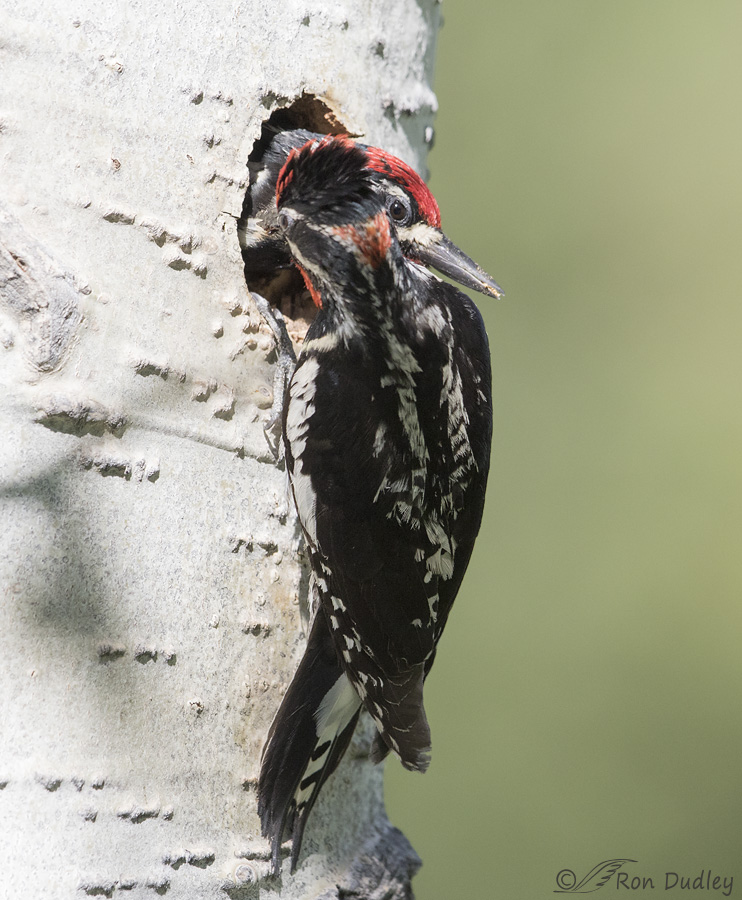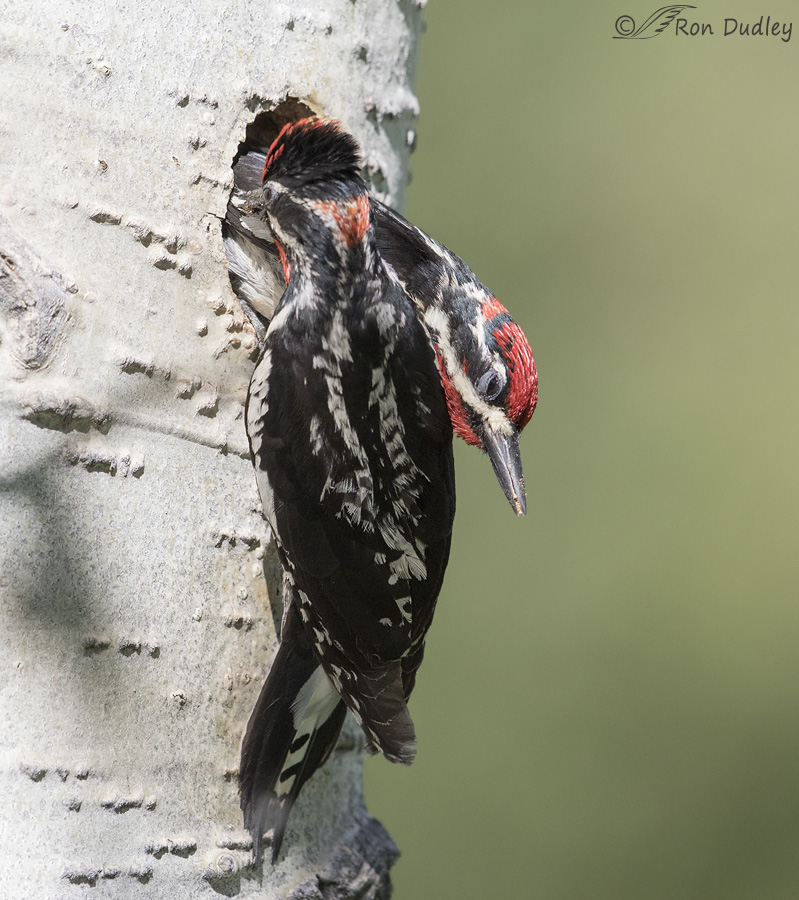Last June I spent parts of several days photographing Red-naped Sapsuckers at their nest cavity in the Uinta Mountains. These woodpeckers were fanatically devoted to their youngsters (that I never saw) and I was extremely impressed by how hard they worked at feeding them and keeping the nest cavity clean.

1/1250/ f/4, ISO 800, Canon 7D Mark II, Canon EF 500mm f/4L IS II USM , not baited, set up or called in
They were feeding ants to their offspring and made countless trips to the cavity with their bills loaded with them. The chicks must have been quite young because they never poked their heads out of the entrance. This is one of the few photos I got of either parent with its red crown erected.

1/3200/ f/5, ISO 640, Canon 7D Mark II, Canon EF 500mm f/4L IS II USM , not baited, set up or called in
Typically one adult would enter the cavity and stay with the chicks until the other parent showed up with food. Then the arriving parent would move its head to the side to allow the exit of the adult in the nest. Often the bird leaving would have a bill full of wood chips or chick fecal pellets and here we can see some small chips in the bill of the exiting parent. Sometimes their bills were loaded with gobs of wood chips.

1/3200/ f/5, ISO 640, Canon 7D Mark II, Canon EF 500mm f/4L IS II USM , not baited, set up or called in
The exiting parent would literally explode out of the cavity and it was always difficult to photograph. To protect their eye as they passed by so closely to their mate they would typically close their eyelid (not their nictitating membrane) as this bird has done so I seldom got eye contact or a catch light during the process.
These woodpeckers would keep this exhausting regimen going for hours at a time with only brief breaks for rest and feeding themselves. I was curious to know if the typical feeding schedule of Red-naped Sapsuckers has been studied and documented so I did a little research. Here’s what Cornell’s Birds of North America Online has to say on the subject:
- “Feeding visits every 7 min for first 5–6 d; afterward, feeding visits up to every 2 min from dawn until dusk”
It makes me tired just to contemplate such a schedule.
Ron
On a largely unrelated note may I be so bold as to suggest that my readers consider watching a new episode of American Experience on PBS titled Rachel Carson? I watched most of it last night and plan to finish it tonight. As most of you know Carson’s book Silent Spring is widely credited with helping to launch the environmental movement and her collective groundbreaking work revolutionized our relationship with the natural world. Her life story as documented by American Experience is a fascinating one.
Better watch it while you can before Trump gets his hands on federal funding for the Corporation for Public Broadcasting. CPB helps to fund organizations like PBS and NPR which are favorite targets among conservatives. Such a move has already been threatened.


I never read Silent Spring, and these days I’m not sure I could make it through. I did manage to watch the whole American Experience show, and am glad I did. I am amazed by the way the fight against truth is still ongoing, perhaps now more than ever…
We used to hear an absolute din of bird song at dawn in the Spring…I was so impressed, I tried to tape them…Now we hear one or two individuals, usually a robin or a mockingbird—an almost “Silent Spring”…,
Sad, isn’t it? Tragic is an even better word for the situation.
Silent Spring was something I read early – and it has stayed with me.
It really is amazing how hard birds work isn’t it? Feeding their young every two minutes? I need to lie down just thinking about it. I agree with you on the baby making process too. With that sort of work? No. Hell no.
EC, I (we) only had one child. I can’t imagine what it would be like for parents with 6-12 of them. Or more. (We have LOTS of families that large here in Utah…)
My dad’s undergrad degree was in outdoor/environmental education, so Silent Spring was an early read for me. Thanks for the link.
Great behavioral shots. I need a nap after learning of their feeding schedule!
I don’t think I read it until my early college years, Marty – 1967 perhaps. It sure opened my eyes!
We have Yellow bellied Sapsuckers come to our maple trees on migration. So it is ants that go to the sap in the holes they make that they feed their babies. I think the adults while they are here just drink the sap as it is probably too cold for ants. Great series, as usual.
Thank you, Judy.
Wonderful photos! I just realized yesterday that I was extremely privileged to have a couple of encounters with a Red-naped Sapsucker at Hueco Tanks – apparently they are rare here. I’m glad that they are driven to reproduce because they are great birds. I’m hoping to have an opportunity to watch the Rachel Carson episode tomorrow.
I hope you enjoy the documentary, Susan. Carson was someone special.
These shots are terrific!
I can’t thank you enough for the PBS episode on Rachel Carson. As a young boy toward the end of WWII we all had to go to the town hall and be sprayed with DDT. I watched a great number of Robins die (1950’s) on our front lawn because of DDT. “Silent Spring” was required reading in my Biology class when I taught Biology some years ago. All I can do now is hope it made impression enough on my students that they will be active against the forthcoming attack by the present administration on the environment. I am terribly concerned at the end of 4 years we will have taken giant steps backward toward climate change, striving for healthy air, and a healthy environment.
Thanks again for this link, much appreciated.
My fears completely, Dick. Not knowing is one thing but ignoring, being a know-it-all, disagreeing with the science and just being oppositional to all that has been proven is another. Back then, they didn’t know but now we do.
Dick, being born in 1947 I must have missed the wholesale spraying of DDT on many Americans by a whisker. Troubling that it was done to you and many others.
I used to require that my students learn the chemical name for DDT – dichlorodiphenyltrichloroethane. Once they learned that mouthful some of them remembered it for years to come. I’ve had ex students from decades ago come up to me and proudly demonstrate that they could still say it from memory.
Ron, I was born in 1936 and have remembered a ton of stuff during my formative years. Watching the whole Carson episode, I don’t mind mentioning that it brought tears to my eyes. She was a strong lady who fought hard and for the right reasons. The only problem is that Companies and Corporations still are fighting for the almighty dollar when it comes to poisons, toxic substances, etc., but at least her efforts are still living on and the public is now more informed. Hopefully the public will not allow higher places to get away with alternate facts and will hold them accountable. Democracy is messy, but it is the best there is!
Birds have such a high metabolic rate, it’s a miracle they don’t burn out with such a frantic feeding schedule…as fior proposed PBS defunding, I’ve had about as much as I can stand already! I want a new vote!!!
Patty, I think if I was a sapsucker I’d consider staying on my wintering grounds all year – to hell with making babies.
The woodpeckers “schedule” for parenting appears to be absolutely exhausting! Great captures of the process! 🙂 Thx for the “heads up: on Rachel Carson episode.
Thank you, Judy.